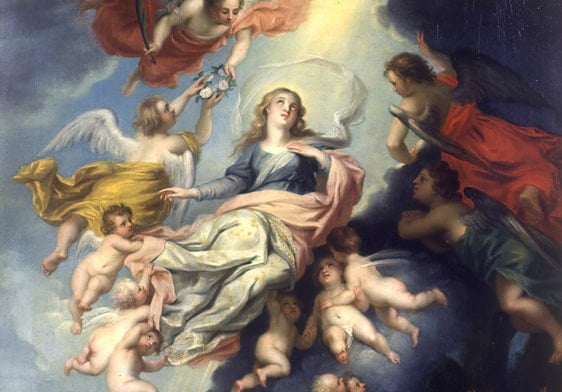
Dear Father, I have a Protestant friend who thinks we Catholics are foolish for believing in the bodily Assumption of Our Lady into heaven when there is no reference to it in the Scriptures. How can I answer her?
As we have said in this column a number of times over the years, there are many truths we believe as Catholics that are not explicit in the Scriptures, but are part of the tradition of the Church going back to the earliest centuries. Among them are the belief in Purgatory and in the Immaculate Conception of Our Lady.
The very canon, or list, of the books in the Bible is another fact not found in the Scriptures, but comes rather from the tradition of the Church.
What is the evidence of tradition for the Assumption, which was defined by Pope Pius XII as late as 1950?
To begin with, we can say that when a truth has been defined as a dogma of faith, as is the case here, it is because the Church is absolutely certain that it is true. Popes do not “invent” dogmas. They find them in the constant and firm belief of the Church.
The tradition of Our Lady’s Assumption goes back to the earliest centuries. The earliest known account is the Liber Requiei Mariae (Book of the Repose of Mary), which was probably composed in the 4th Century, but possibly as early as the 3rd.
It is regarded as an apocryphal work, meaning not officially approved by the Church, but the very fact that it speaks of Our Lady’s Assumption is evidence of the belief of many people at that time.
Another work which attests to the Assumption is the Six Books Dormition Narratives, of the 5th and 6th centuries, and the De Obitu S. Dominae (On the Death of the Holy Lady), which is a summary of the Six Books.
The first Father of the Church in the West to witness to the tradition of the Assumption of Mary was St Gregory of Tours, who died in 594 AD. He writes:
“Finally, when blessed Mary, having completed the course of her earthly life, was about to be called from this world, all the apostles, coming from their different regions, gathered together in her house. When they heard that she was about to be taken up out of the world, they kept watch together with her.
And behold, the Lord Jesus came with his angels and, taking her soul, handed it over to the archangel Michael and withdrew. At dawn, the apostles lifted up her body on a pallet, laid it in a tomb, and again the Lord presented himself to them and ordered that her holy body be taken and carried up to heaven.
There she is now, joined once more to her soul; she exults with the elect, rejoicing in the eternal blessings that will have no end” (L. Gambero, Mary and the Fathers of the Church, Ignatius 1999, p. 353).
An Eastern Father of the Church who testifies to this tradition is St John Damascene, who died in 749. He writes in a prayer to Mary:
“The assembly of apostles carried you, the Lord God’s true Ark, as once the priests carried the symbolic ark, on their shoulders. They laid you in the tomb, through which, as if through the Jordan, they will conduct you to the promised land, that is to say, the Jerusalem above, mother of all the faithful, whose architect and builder is God. Your soul did not descend to Hades, neither did your flesh see corruption.
Your virginal and uncontaminated body was not abandoned in the earth, but you are transferred into the royal dwelling of heaven, you, the Queen, the sovereign, the Lady, God’s Mother, the true God-bearer…” (Homily 1 on the Dormition 12-13).
As early as the 6th Century a feast of the Dormition, or death, of Our Lady began to be celebrated on 15 August in both Jerusalem and Rome.
By the 16th Century the tradition of Mary’s Assumption was firmly implanted in the Church’s prayers.
The Rosary, which was standardised by the Dominican Pope Pius V in 1569, had the Assumption of Our Lady as the fourth Glorious Mystery, as it has been ever since.
And a Manual of Devout Prayers and Devotions, printed in England in 1688, of which I have a copy, has the feast of the “Assumption of the Blessed Virgin” celebrated on 15 August.
So, with this constant tradition going back to the early Church, there can be no question about the bodily Assumption of Our Lady, even though it is no explicit in the Scriptures.
Related:
